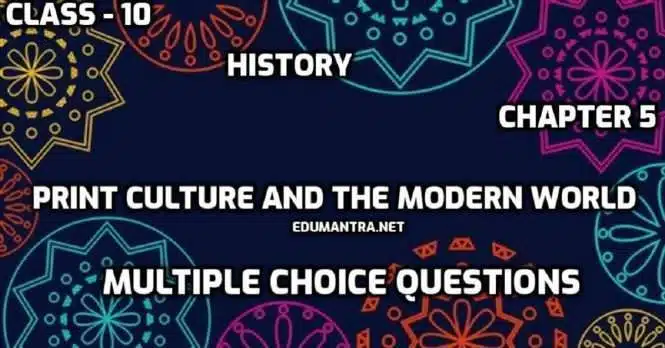
Dear students as per the latest exam pattern of CBSE Class 10 social science multiple choice questions and answers will be a part of your question paper. Here we are providing mcq for class 10 social science History chapter 5 Print Culture and The Modern World . So let’s dive in for imp mcq of sst class 10
CHAPTER 5
Print Culture and The Modern World
Multiple Choice Questions
Q.1. The earliest kind of print technology was developed in Japan, Korea and………..
(a) China
(b) India
(c) Germany
(d) France
Q.2. The paper was invented in………..
(a) India
(b) England
(c) China
(d) France
Q.3. What is calligraphy?
(a) The art of beautiful and stylish writing
(b) A type of building
(c) A type of writing used during neolithic age
(d) A type of writing used in Egypt
Q.4. who among the following brought hand-‘painting technology Into Japan around 768-770 AD?
(a) Buddhist missionaries
(b) Japanese Traders
(c) European Traders
(d) None of the above
Q.5. Which is the oldest printed book of Japan?
(a) Bible
(b) Diamond Sutra
(c) Mahabharata
(d) Ukiyo
Q.6. Who developed the first printing press?
(a) Johann Gutenberg
(b) lssac Newton
(c) Marco Polo
(d) Newcomen
Q.7. Which was the first book printed by Johann Gutenberg?
(a) The Koran
(b) The Bible
(c) Diamond Sutra
(d) Ramcharitmanas
Q.8. Who wrote 95 Theses?
(a) Martin Luther
(b) Johann Gutenberg
(c) J.V. Schley
(d) Charles Dickens
Q.9. Who said, “Printing is the ultimate gift of God and the greatest one.”
(a) Charles Dickens
(b) J.V. Schely
(c) Mahatma Gandhi
(d) Martin Luther
Q.10. Pocket size books that are sold by travelling pedlars.
(a) Chapbook
(b) Cheapbook
(c) Dictionary
(d) Almanac
Q.11. Who were called ‘Chapmen’?
(a) Book seller
(b) Paper seller
(c) Workers of printing press
(d) Seller of ‘penny chap books’.
Q.12. Which one among the following is an ancient name of Tokyo?
(a) Osaka
(b) Nagano
(c) Edo
(d) Gifu
Q.13. Which of the following is an Enlightenment thinker whose writings are said to have created conditions for a revolution is France?
(a) Louise Sebastin Mercier
(b) Rousseau
(c) Mennochio
(d) Gutenberg
Q.14. By the mid 19th century, ………….. had perfected the power driven cylindrical press.
(a) Johann Gutenberg
(b) S. Richard
(c) Richard M.Hoe
(d) Vivian Richard
Q.15. Who authored `Gitagouinda’ ?
(a) Jayadeva
(b) Mahatma Gandhi
(c) Munshi Premchand
(d) Chandu Menon
Q.16. The Book, ‘Chote Aur Bade Ka Sawal’ wrote about:
(a) the link between caste and class exploitation
(b) the injustices of the caste system
(c) restrictions on the vernacular press
(d) ill treatment of widows
Q.17. Which of the following is the meaning of `Biliotheque Bleue’?
(a) An author
(b) Low price books
(c) Monuments
(d) None of these
Q.18. The printing was first introduced in India by which one of the following?
(a) East India Company officials
(b) Indian reformers
(c) Portuguese missionaries
(d) Arabic traders
Q.19.Who wrote ‘Amar Jtban’ ?
(a) Rokeya Hossein
(b) Kailashbashini Debi
(c) Tarabai Shinde
(d) Rashsundari Debi
Q.20. Who was the author of `Gulamgirl a book on caste injustices?
(a) Raja Ram Mohan Roy
(b) Mahatma Gandhi
(c) Jyotiba Phule
(d) B.R. Ambedkar
Q.21. Which one of the following was published by Raja Ram Mohan Roy?
(a) Sambad Kaumudi
(b) Shamsul Akbar
(c) Punjab Kesri
(d) Chandrika
Q.22. Who printed the first Tamil book?
(a) The Protestant Priests
(b) The Catholic Priests
(c) Ulemas
(d) None of the above.
We hope you are enjoying these CBSE class 10 social science multiple choice questions and answers. If yes we have also given Class 10 sst MCQ PDF Download link at the bottom of this page. So that you do not have to browse the internet repeatedly for class 10 sst mcq questions. You can save them offline.
Q.23. Who among the following was associated with the newspaper Wesart ?
(a) Mahatma Gandhi
(b) Subhas Chandra Bose
(c) Bal Gangadhar Tilak
(d) A.O. Hume
Q.24. The circulation of handwritten manuscripts remained limited because:
Or
Why was reading of manuscript not easy in India? Choose the appropriate reason from the following options:
(a) they were fragile and awakward to handle
(b) they could not be carried around
(c) they could not be read easily
(d) all the above
Q.25.Which of the following was a book showing links between caste and class exploitation ?
(a) Gulamgiri
(b) Amar Jiban
(c) Istri Dharm Vichar
(d) Chhote Aur Bade Ka Sawal
Q.26. When did the first printing press come to India?
(a) In the middle of the 16th century
(b) In the middle of the 17th century
(c) In the middle of the 18th century
(d) In the middle of the 19th century
Q.27. Who among the following was against the Catholic Church?
(a) Martin Luther
(b) Gutenberg
(c) Jaidev
(d) John Augustine
Q.28. Who among the following published ‘Punjab Kesri ?
(a) Balgangadhar Tilak
(b) Mahatma Gandhi
(c) Bhagat Singh
(d) B.R. Ambedkar
ANSWERS:-
| (a) China |
| (c) China |
| (a) The art of beautiful and stylish writing |
| (a) Buddhist missionaries |
| (b) Diamond Sutra |
| (a) Johann Gutenberg |
| (b) The Bible |
| (a) Martin Luther |
| (d) Martin Luther |
| (a) Chapbook |
| (d) Seller of ‘penny chap books’. |
| (c) Edo |
| (b) Rousseau |
| (c) Richard M.Hoe |
| (a) Jayadeva |
| (a) the link between caste and class exploitation |
| (b) Low price books |
| (c) Portuguese missionaries |
| (d) Rashsundari Debi |
| (c) Jyotiba Phule |
| (a) Sambad Kaumudi |
| (b) The Catholic Priests |
| (c) Bal Gangadhar Tilak |
| (d) all the above |
| (a) Gulamgiri |
| (a) In the middle of the 16th century |
| (a) Martin Luther |
| (a) Balgangadhar Tilak |